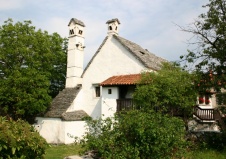Difference between revisions of "Škratelj Homestead"
m (moved Ita Rina Museum to Škratelj Homestead: muzej bo spremenil svoj naslov) |
|||
| Line 6: | Line 6: | ||
{{Infobox | {{Infobox | ||
|image = Ita Rina Museum.jpg | |image = Ita Rina Museum.jpg | ||
| − | |local name = | + | |local name = Škrateljnova hiša, spomenik kraške arhitekture |
|street = Kraška cesta 26 | |street = Kraška cesta 26 | ||
|town = Sl-6215 Divača | |town = Sl-6215 Divača | ||
| Line 21: | Line 21: | ||
{{Contact | {{Contact | ||
|name = Lilijana Nedič | |name = Lilijana Nedič | ||
| − | |role = Museum Collection Manager | + | |role = Ita Rina Museum Collection Manager, Slovenian Cinematheque |
|telephone = 386 (0) 1 43 42 505 | |telephone = 386 (0) 1 43 42 505 | ||
|email = lilijana.nedic@kinoteka.si | |email = lilijana.nedic@kinoteka.si | ||
| Line 28: | Line 28: | ||
}} | }} | ||
{{Teaser| | {{Teaser| | ||
| − | Škratelj | + | [[Škratelj Homestead]] in Divača features a permanent exhibition on Slovene movie star Ida Kravanja (stage name [[Ita Rina]]), which was conceived by the [[Slovenian Cinematheque Museum Department]] and opened in [[Established::2000]] due to support of the [[Municipality of Divača]] and [[Institute for the Protection of Cultural Heritage of Slovenia, Nova Gorica]]. There are plans for the permanent exhibition on the actress to be supplemented by the '''Museum of Slovene Film Actors''' that will also include also a small cinema hall for screenings and workshops. The renovation is supported by the donation of the Norwegian Financial Mechanism. |
[[Image:Ita Rina poster.jpg]] | [[Image:Ita Rina poster.jpg]] | ||
| − | '''Ita Rina''' (1907-1979) was the first Slovene to achieve international star status - her heyday was in the late 1920s when she starred in the film ''Erotikon'' (1929) by Czech director Gustav Machaty, which enjoyed major box-office success both in Europe and in the USA. }} | + | '''Ita Rina''' (1907-1979) was the first Slovene to achieve international star status - her heyday was in the late 1920s when she starred in the film ''Erotikon'' (1929) by Czech director Gustav Machaty, which enjoyed major box-office success both in Europe and in the USA. |
| + | }} | ||
| − | |||
| − | + | ==Škratelj House== | |
| + | The architecture of Škratelj House and its courtyard (borjač), a monument of 17th-century Karst architecture, is well preserved. The exhibition on the first floor presents the life of Ita Rina and the development of Slovene film during her day. | ||
| − | == | + | ==Ita Rina== |
| − | The | + | The young Slovene actress Ita Rina first lived in Berlin, at that time centre of European film industry, and her debut was in the role of a chambermaid in ''Was die Kinder ihren Eltern verschweigen''. After ''Erotikon'' she performed in the first Czech sound film ''Gallows Toni'' in 1930. She declined an invitation from Hollywood and instead moved to Belgrade, got married and changed her name to Tamara Djordjević. Thereafter she starred in several more films, including the Yugoslav production War (1960), however she never managed to regain her earlier fame. After the war she also appeared in several Yugoslav theatre productions. Ita Rina died in Budva, and was buried in Belgrade. |
Revision as of 03:04, 22 February 2010
Škratelj House
The architecture of Škratelj House and its courtyard (borjač), a monument of 17th-century Karst architecture, is well preserved. The exhibition on the first floor presents the life of Ita Rina and the development of Slovene film during her day.
Ita Rina
The young Slovene actress Ita Rina first lived in Berlin, at that time centre of European film industry, and her debut was in the role of a chambermaid in Was die Kinder ihren Eltern verschweigen. After Erotikon she performed in the first Czech sound film Gallows Toni in 1930. She declined an invitation from Hollywood and instead moved to Belgrade, got married and changed her name to Tamara Djordjević. Thereafter she starred in several more films, including the Yugoslav production War (1960), however she never managed to regain her earlier fame. After the war she also appeared in several Yugoslav theatre productions. Ita Rina died in Budva, and was buried in Belgrade.
See also
External links
- Ita Rina Museum website – Museum of Slovene Actors under construction
- Ita Rina in Wikipedia
- An article at the EEA Grants page – Bringing Slovenian film history into the light




